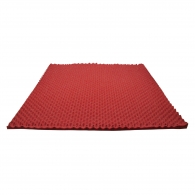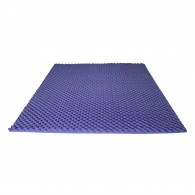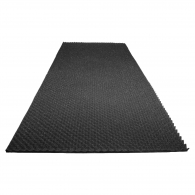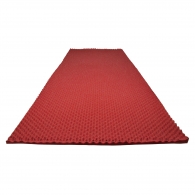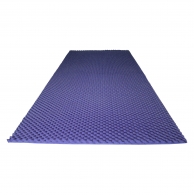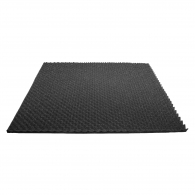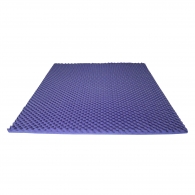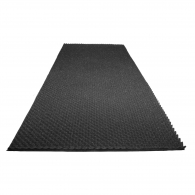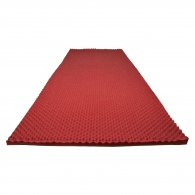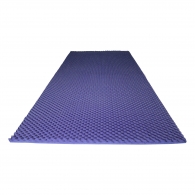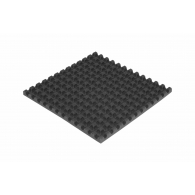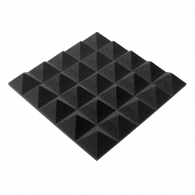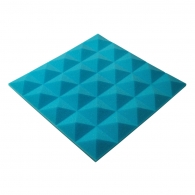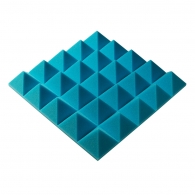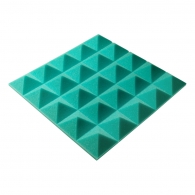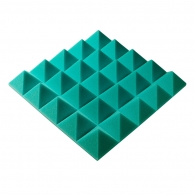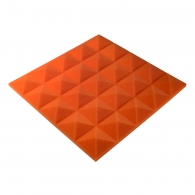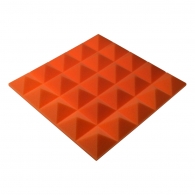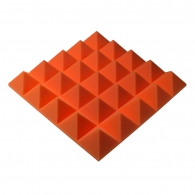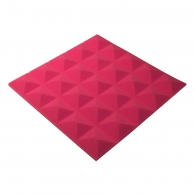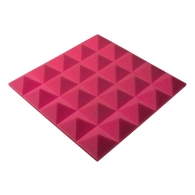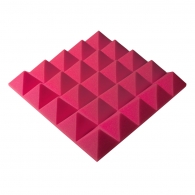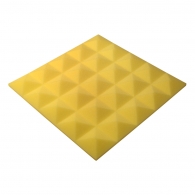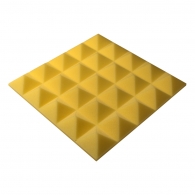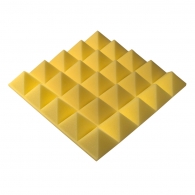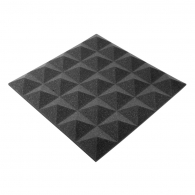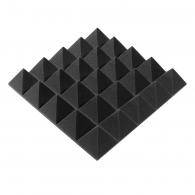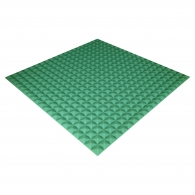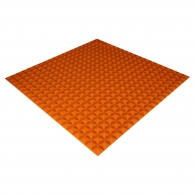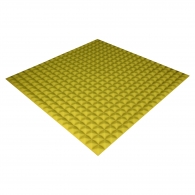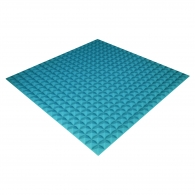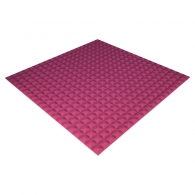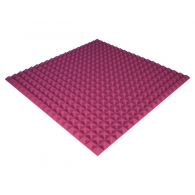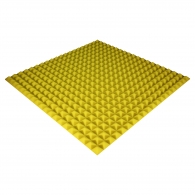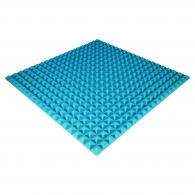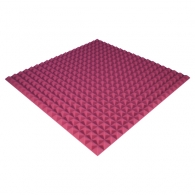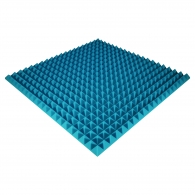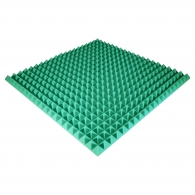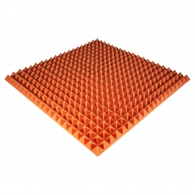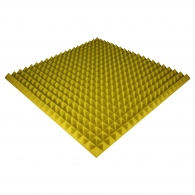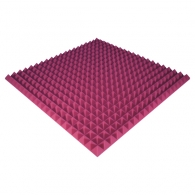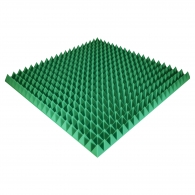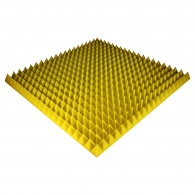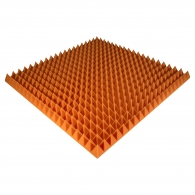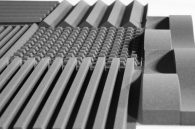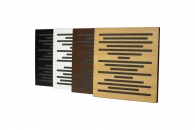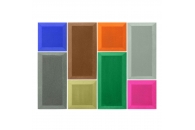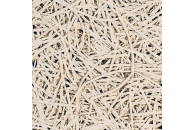Acoustic panels
-
Burgundy acoustic non-combustible foam rubber Ecosound Volna is used in combination with bass traps and other acoustic diffusers, as well as additional soundproofing of the room, in concert halls, office centers, recording studios, on radio and television, as well as in other rooms where it is nece..$18.05
-
Sound-absorbing and sound-correcting acoustic non-combustible foam rubber Ecosound Violet Wave. Foam rubber is made from non-combustible polyurethane foam, which does not contain toxic and harmful components. This model of foam rubber is produced in slabs measuring 100 cm x 100 cm and 2 cm high. Th..$18.05
-
If you need to achieve the highest quality sound level, more intelligible speech, get rid of unnecessary noise and echo, Ecosound Wave acoustic foam is ideal for these purposes. This foam belongs to non-combustible types of acoustic foam rubber. It can be used in recording studios, concert halls, o..$36.10
-
Ecosound Wave Burgundy High Performance Flame Retardant Acoustic Foam is ideal for removing extraneous noise effects, correcting mid and high frequencies, and also eliminates reverberation and primary reflections. The sound absorption coefficient is 0.65. It is made from hypoallergenic, safe and hi..$36.10
-
In order to achieve good room acoustics, it is necessary to choose the right acoustic components that can correct the sound and absorb noise effects, bringing the room acoustics to perfection. Acoustic flame retardant foam rubber Ecosound Violet Wave is suitable for this purpose. In combination wit..$36.10
-
Flame retardant acoustic foam Ecosound Wave black graphite. It is used indoors to correct sound, improve its quality, as well as to reduce and absorb noise effects. This foam allows you to achieve perfect room acoustics, high sound quality and maximum speech intelligibility. In addition, this foam ..$25.43
-
Efficient acoustic non-combustible foam rubber Ecosound Wave. This foam is used to correct sound, absorb a variety of noise effects and echoes, eliminate reverberation and achieve higher quality room acoustics. For greater effect, acoustic flame retardant foam is best used in combination with bass ..$25.43
-
Acoustic non-combustible foam rubber Ecosound Wave has a wave-like surface shape, which allows you to achieve perfect room acoustics, high sound quality and maximum speech intelligibility. Acoustic foam Volna is used in professional recording studios, concert halls, bars and restaurants, on televis..$50.86
-
Acoustic non-combustible foam rubber Ecosound Burgundy wave with a wave-shaped surface. Foam rubber is used in rooms to eliminate extraneous noise effects and echoes, to achieve reverberation optimization and create ideal acoustics. With the help of Wave acoustic foam, you can improve the sound qua..$50.86
-
High-performance acoustic foam Ecosound Wave is a non-combustible foam that has a wavy surface, 3 cm thick. It perfectly copes with the correction of room acoustics, allowing you to achieve the highest quality sound level and get rid of noise effects. This type of foam rubber is used in combination..$50.86
-
Wave cellular foam is used as acoustic foam for sound absorption in technical rooms, diesel generators, production rooms - where it is necessary to reduce the noise level, adjust the reverberation level to the norms, as well as for studio rooms, announcer and vocal booths, home theaters, listening ..$9.30
-
Acoustic panel pyramid - the most popular type of acoustic panels. The pyramid acoustic panel has a wider sound absorption spectrum compared to its counterparts due to a special relief that allows better absorption of sound waves into the porous structure of the acoustic foam rubber. Extremely easy..$4.02
-
Acoustic panel pyramid - the most popular type of acoustic panels. The pyramid acoustic panel has a wider sound absorption spectrum compared to its counterparts due to a special relief that allows better absorption of sound waves into the porous structure of the acoustic foam rubber. Extremely easy..$2.54
-
Acoustic panel pyramid - the most popular type of acoustic panels. The pyramid acoustic panel has a wider sound absorption spectrum compared to its counterparts due to a special relief that allows better absorption of sound waves into the porous structure of the acoustic foam rubber. Extremely easy..$3.17
-
Acoustic panel pyramid - the most popular type of acoustic panels. The pyramid acoustic panel has a wider sound absorption spectrum compared to its counterparts due to a special relief that allows better absorption of sound waves into the porous structure of the acoustic foam rubber. Extremely easy..$3.99
-
Acoustic panel pyramid - the most popular type of acoustic panels. The pyramid acoustic panel has a wider sound absorption spectrum compared to its counterparts due to a special relief that allows better absorption of sound waves into the porous structure of the acoustic foam rubber. Extremely easy..$2.54
-
Acoustic panel pyramid - the most popular type of acoustic panels. The pyramid acoustic panel has a wider sound absorption spectrum compared to its counterparts due to a special relief that allows better absorption of sound waves into the porous structure of the acoustic foam rubber. Extremely easy..$3.17
-
Acoustic panel pyramid - the most popular type of acoustic panels. The pyramid acoustic panel has a wider sound absorption spectrum compared to its counterparts due to a special relief that allows better absorption of sound waves into the porous structure of the acoustic foam rubber. Extremely easy..$3.99
-
Acoustic panel pyramid - the most popular type of acoustic panels. The pyramid acoustic panel has a wider sound absorption spectrum compared to its counterparts due to a special relief that allows better absorption of sound waves into the porous structure of the acoustic foam rubber. Extremely easy..$3.20
-
Acoustic panel pyramid - the most popular type of acoustic panels. The pyramid acoustic panel has a wider sound absorption spectrum compared to its counterparts due to a special relief that allows better absorption of sound waves into the porous structure of the acoustic foam rubber. Extremely easy..$3.17
-
Acoustic panel pyramid - the most popular type of acoustic panels. The pyramid acoustic panel has a wider sound absorption spectrum compared to its counterparts due to a special relief that allows better absorption of sound waves into the porous structure of the acoustic foam rubber. Extremely easy..$3.99
-
Acoustic panel pyramid - the most popular type of acoustic panels. The pyramid acoustic panel has a wider sound absorption spectrum compared to its counterparts due to a special relief that allows better absorption of sound waves into the porous structure of the acoustic foam rubber. Extremely easy..$2.54
-
Acoustic panel pyramid - the most popular type of acoustic panels. The pyramid acoustic panel has a wider sound absorption spectrum compared to its counterparts due to a special relief that allows better absorption of sound waves into the porous structure of the acoustic foam rubber. Extremely easy..$3.17
-
Acoustic panel pyramid - the most popular type of acoustic panels. The pyramid acoustic panel has a wider sound absorption spectrum compared to its counterparts due to a special relief that allows better absorption of sound waves into the porous structure of the acoustic foam rubber. Extremely easy..$3.99
-
Acoustic panel pyramid - the most popular type of acoustic panels. The pyramid acoustic panel has a wider sound absorption spectrum compared to its counterparts due to a special relief that allows better absorption of sound waves into the porous structure of the acoustic foam rubber. Extremely easy..$2.54
-
Acoustic panel pyramid - the most popular type of acoustic panels. The pyramid acoustic panel has a wider sound absorption spectrum compared to its counterparts due to a special relief that allows better absorption of sound waves into the porous structure of the acoustic foam rubber. Extremely easy..$3.17
-
Acoustic panel pyramid - the most popular type of acoustic panels. The pyramid acoustic panel has a wider sound absorption spectrum compared to its counterparts due to a special relief that allows better absorption of sound waves into the porous structure of the acoustic foam rubber. Extremely easy..$3.99
-
Acoustic panel pyramid - the most popular type of acoustic panels. The pyramid acoustic panel has a wider sound absorption spectrum compared to its counterparts due to a special relief that allows better absorption of sound waves into the porous structure of the acoustic foam rubber. Extremely easy..$2.82
-
Acoustic panel pyramid - the most popular type of acoustic panels. The pyramid acoustic panel has a wider sound absorption spectrum compared to its counterparts due to a special relief that allows better absorption of sound waves into the porous structure of the acoustic foam rubber. Extremely easy..$5.31
-
Color: green ; size: 100x100 cm ; panel thickness: 15mm ; sound absorption coefficient: 0.63 ; Material: Acoustic foam ; material density: 30 kg/m.cub. ; normal number of non-standard recesses: less than 1% ; number of pores per 1 sq. mm: about 40 pcs ; admissible error of panel height: up to 5 mm ..$6.70
-
Color: orange ; size: 100x100 cm ; panel thickness: 15mm ; sound absorption coefficient: 0.63 ; Material: Acoustic foam ; material density: 30 kg/m.cub. ; normal number of non-standard recesses: less than 1% ; number of pores per 1 sq. mm: about 40 pcs ; admissible error of panel height: up to 5 mm..$6.70
-
Color: yellow ; size: 100x100 cm ; panel thickness: 15mm ; sound absorption coefficient: 0.63 ; Material: Acoustic foam ; material density: 30 kg/m.cub. ; normal number of non-standard recesses: less than 1% ; number of pores per 1 sq. mm: about 40 pcs ; admissible error of panel height: up to 5 mm..$6.70
-
Color: blue ; size: 100x100 cm ; panel thickness: 20 mm ; sound absorption coefficient: 0.65 ; Material: Acoustic foam ; material density: 30 kg/m.cub. ; normal number of non-standard recesses: less than 1% ; number of pores per 1 sq. mm: about 40 pcs ; admissible error of panel height: up to 5 mm ..$7.88
-
Color: green ; size: 100x100 cm ; panel thickness: 20 mm ; sound absorption coefficient: 0.65 ; Material: Acoustic foam ; material density: 30 kg/m.cub. ; normal number of non-standard recesses: less than 1% ; number of pores per 1 sq. mm: about 40 pcs ; admissible error of panel height: up to 5 mm..$7.44
-
Color: orange ; size: 100x100 cm ; panel thickness: 20 mm ; sound absorption coefficient: 0.65 ; Material: Acoustic foam ; material density: 30 kg/m.cub. ; normal number of non-standard recesses: less than 1% ; number of pores per 1 sq. mm: about 40 pcs ; admissible error of panel height: up to 5 m..$10.47
-
Color: pink ; size: 100x100 cm ; panel thickness: 20 mm ; sound absorption coefficient: 0.65 ; Material: Acoustic foam ; material density: 30 kg/m.cub. ; normal number of non-standard recesses: less than 1% ; number of pores per 1 sq. mm: about 40 pcs ; admissible error of panel height: up to 5 mm ..$7.44
-
Acoustic foam panel Ecosound Pyramid Color 20 mm thick, size 100x100 cm, yellow Color: yellow ; size: 100x100 cm ; panel thickness: 20 mm ; sound absorption coefficient: 0.65 ; Material: Acoustic foam ; material density: 30 kg/m.cub. ; normal number of non-standard recesses: less than 1% ; number o..$7.44
-
Color: green ; size: 100x100 cm ; panel thickness: 25mm ; sound absorption coefficient: 0.67 ; Material: Acoustic foam ; material density: 30 kg/m.cub. ; normal number of non-standard recesses: less than 1% ; number of pores per 1 sq. mm: about 40 pcs ; admissible error of panel height: up to 5 mm ..$9.95
-
Color: orange ; size: 100x100 cm ; panel thickness: 25mm ; sound absorption coefficient: 0.67 ; Material: Acoustic foam ; material density: 30 kg/m.cub. ; normal number of non-standard recesses: less than 1% ; number of pores per 1 sq. mm: about 40 pcs ; admissible error of panel height: up to 5 mm ..$9.95
-
Color: pink ; size: 100x100 cm ; panel thickness: 25mm ; sound absorption coefficient: 0.67 ; Material: Acoustic foam ; material density: 30 kg/m.cub. ; normal number of non-standard recesses: less than 1% ; number of pores per 1 sq. mm: about 40 pcs ; admissible error of panel height: up to 5 mm ;..$9.95
-
Color: yellow ; size: 100x100 cm ; panel thickness: 25mm ; sound absorption coefficient: 0.67 ; Material: Acoustic foam ; material density: 30 kg/m.cub. ; normal number of non-standard recesses: less than 1% ; number of pores per 1 sq. mm: about 40 pcs ; admissible error of panel height: up to 5 mm..$9.95
-
Color: blue ; size: 100x100 cm ; panel thickness: 30mm ; sound absorption coefficient: 0.7 ; Material: Acoustic foam ; material density: 30 kg/m.cub. ; normal number of non-standard recesses: less than 1% ; number of pores per 1 sq. mm: about 40 pcs ; admissible error of panel height: up to 5 mm ; ..$11.29
-
Color: pink ; size: 100x100 cm ; panel thickness: 30mm ; sound absorption coefficient: 0.7 ; Material: Acoustic foam ; material density: 30 kg/m.cub. ; normal number of non-standard recesses: less than 1% ; number of pores per 1 sq. mm: about 40 pcs ; admissible error of panel height: up to 5 mm ; ..$11.29
-
Color: yellow ; size: 100x100 cm ; panel thickness: 30mm ; sound absorption coefficient: 0.7 ; Material: Acoustic foam ; material density: 30 kg/m.cub. ; normal number of non-standard recesses: less than 1% ; number of pores per 1 sq. mm: about 40 pcs ; admissible error of panel height: up to 5 mm ..$11.29
-
Color: green ; size: 100x100 cm ; panel thickness: 30mm ; sound absorption coefficient: 0.7 ; Material: Acoustic foam ; material density: 30 kg/m.cub. ; normal number of non-standard recesses: less than 1% ; number of pores per 1 sq. mm: about 40 pcs ; admissible error of panel height: up to 5 mm ;..$11.29
-
Color: orange ; size: 100x100 cm ; panel thickness: 30mm ; sound absorption coefficient: 0.7 ; Material: Acoustic foam ; material density: 30 kg/m.cub. ; normal number of non-standard recesses: less than 1% ; number of pores per 1 sq. mm: about 40 pcs ; admissible error of panel height: up to 5 mm ..$13.02
-
Color: blue ; size: 100x100 cm ; panel thickness: 50 mm ; sound absorption coefficient: 0.75 ; Material: Acoustic foam ; material density: 30 kg/m.cub. ; normal number of non-standard recesses: less than 1% ; number of pores per 1 sq. mm: about 40 pcs ; admissible error of panel height: up to 5 mm ..$16.82
-
Color: green ; size: 100x100 cm ; panel thickness: 50 mm ; sound absorption coefficient: 0.75 ; Material: Acoustic foam ; material density: 30 kg/m.cub. ; normal number of non-standard recesses: less than 1% ; number of pores per 1 sq. mm: about 40 pcs ; admissible error of panel height: up to 5 mm..$16.82
-
Color: orange ; size: 100x100 cm ; panel thickness: 50 mm ; sound absorption coefficient: 0.75 ; Material: Acoustic foam ; material density: 30 kg/m.cub. ; normal number of non-standard recesses: less than 1% ; number of pores per 1 sq. mm: about 40 pcs ; admissible error of panel height: up to 5 mm..$16.82
-
Color: yellow ; size: 100x100 cm ; panel thickness: 50 mm ; sound absorption coefficient: 0.75 ; Material: Acoustic foam ; material density: 30 kg/m.cub. ; normal number of non-standard recesses: less than 1% ; number of pores per 1 sq. mm: about 40 pcs ; admissible error of panel height: up to 5 m..$16.82
-
Color: pink ; size: 100x100 cm ; panel thickness: 50 mm ; sound absorption coefficient: 0.75 ; Material: Acoustic foam ; material density: 30 kg/m.cub. ; normal number of non-standard recesses: less than 1% ; number of pores per 1 sq. mm: about 40 pcs ; admissible error of panel height: up to 5 mm ..$16.82
-
Color: green ; size: 100x100 cm ; panel thickness: 70 mm ; sound absorption coefficient: 0.8 ; Material: Acoustic foam ; material density: 30 kg/m.cub. ; normal number of non-standard recesses: less than 1% ; number of pores per 1 sq. mm: about 40 pcs ; admissible error of panel height: up to 5 mm ..$22.59
-
Color: yellow ; size: 100x100 cm ; panel thickness: 70 mm ; sound absorption coefficient: 0.8 ; Material: Acoustic foam ; material density: 30 kg/m.cub. ; normal number of non-standard recesses: less than 1% ; number of pores per 1 sq. mm: about 40 pcs ; admissible error of panel height: up to 5 mm..$22.59
-
Color: orange ; size: 100x100 cm ; panel thickness: 70 mm ; sound absorption coefficient: 0.8 ; Material: Acoustic foam ; material density: 30 kg/m.cub. ; normal number of non-standard recesses: less than 1% ; number of pores per 1 sq. mm: about 40 pcs ; admissible error of panel height: up to 5 mm..$22.59
-
Pink colour; size: 100x100 cm ; panel thickness: 70 mm ; sound absorption coefficient: 0.8 ; Material: Acoustic foam ; material density: 30 kg/m.cub. ; normal number of non-standard recesses: less than 1% ; number of pores per 1 sq. mm: about 40 pcs ; admissible error of panel height: up to 5 mm ; ..$22.59
-
Color: blue ; size: 100x100 cm ; panel thickness: 15mm ; sound absorption coefficient: 0.63 ; Material: Acoustic foam ; material density: 30 kg/m.cub. ; normal number of non-standard recesses: less than 1% ; number of pores per 1 sq. mm: about 40 pcs ; admissible error of panel height: up to 5 mm ;..$6.70
-
Color: blue ; size: 100x100 cm ; panel thickness: 25mm ; sound absorption coefficient: 0.67 ; Material: Acoustic foam ; material density: 30 kg/m.cub. ; normal number of non-standard recesses: less than 1% ; number of pores per 1 sq. mm: about 40 pcs ; admissible error of panel height: up to 5 mm ;..$9.95
When developing acoustic design and acoustic correction, acoustic panels are effective in a large number of cases.
Acoustic panels are used to control sound reflections and reduce echoes in rooms where certain sound conditions are required, namely for:
- recording studios,
- post-production studios,
- public audiences,
- theaters,
- cinemas,
- rehearsal rooms,
- temples
- call centers
- schools
Acoustic panels allow you to remove the echo in the room, absorbing sound reflections.
Depending on the application, acoustic panels come in various degrees of absorption.
Our company manufactures and sells the following acoustic panels:
Acoustic panels Cinema Acoustic
When extraneous noise from neighbors is heard at home, cars under the windows are tired, or a runway not far from the house, you should seriously think about soundproofing. Ultimately, home acoustic comfort, as well as healthy sleep, have a beneficial effect on the body. It is impossible to achieve such well-being in a noisy environment.
What is this insulation material?
Acoustic panels , as a rule, are not only a functional material for absorbing noise, but also a decorative function. Like any building material, acoustic panels - for floors, walls , ceilings - have their advantages and disadvantages, and the price is also a controversial issue.
Today, there are a lot of companies that produce soundproof materials for houses. The market is represented by little-known manufacturers, "folk brands", as well as real giant brands, the quality of which can be no doubt. In addition, acoustic materials come with different characteristics, so before you buy panels , always pay attention to them.
Several types of materials
The most common building materials are of two types - hard and soft. The price for them can be completely different, and the main difference is in the method of noise absorption. As a rule, solid acoustic materials have a perforated surface, due to which the noise is damped inside the panel.
Soft acoustic materials have a higher level of sound absorption. In their design, often, the manufacturer provides several additional layers of protection. These, for example, include acoustic foam rubber . Which, by the way, in addition to excellent noise absorption, has a high resistance to mechanical stress, as well as a low price and the easiest installation method. Those who are going to buy soundproofing materials should definitely pay attention to acoustic foam .
Scope and differences of similar materials
Any place where there is sound equipment, where music is played, or films are watched, such building materials are everywhere. And while hard sound-absorbing panels are hard to hide, acoustic foam is invisible to the eye - most likely it is sheathed on the wall, or trimmed with something, which is another plus for those who want to buy it.
Often, acoustic foam is part of the panel structure. But even when only the installation of acoustic foam is required, it is not uncommon. Moreover, if skills are required to install a stretch acoustic ceiling, then installing acoustic foam rubber will not create problems. The only difficulty of installation is the smooth gluing of the "sticky" side.
And even then, the problem is easily solved by marking with an ordinary pencil. The minus of foam rubber is only in an ugly appearance. As for the price, foam rubber is a clear favorite. Cheaper than this material you will not find any analogues.
Acoustic panels
Acoustic panels are an essential tool for controlling sound in any space, whether it be a recording studio, home theater, or office. These panels are designed to absorb sound waves and reduce echoes, creating a more pleasant and acoustically balanced environment.
Acoustic panels come in a variety of materials, shapes, and sizes, but one common option is acoustic foam rubber. This material is lightweight, durable, and effective at absorbing sound waves. Acoustic foam rubber panels are often used to treat walls, ceilings, and even floors to improve the acoustics of a room.
Acoustic correction is another important aspect of acoustic design. This involves identifying and addressing any acoustic issues in a space, such as uneven sound distribution or excessive reverberation. Acoustic panels can help to correct these issues by absorbing sound waves and reducing echoes, leading to a more balanced and pleasant sound environment.
In the USA, acoustic panels are widely used in a variety of settings. Recording studios, for example, often use acoustic panels to create a controlled and acoustically balanced recording environment. Home theaters also benefit from the use of acoustic panels to enhance the sound quality of movies and music.
One common issue that acoustic panels can help to address is echo control. Echoes occur when sound waves bounce off hard surfaces, creating a repetitive and distracting sound. By installing acoustic panels, these sound waves can be absorbed, reducing echoes and creating a more enjoyable listening experience.
For those looking to remove echo in a room in USA, acoustic panels are a practical and effective solution. By installing acoustic panels on the walls, ceilings, and floors of a room, echoes can be significantly reduced, creating a more pleasant and acoustically balanced space.
In an apartment setting, acoustic panels can also be a valuable tool for reducing noise and creating a more peaceful living environment. By installing acoustic panels in common areas such as living rooms or bedrooms, residents can enjoy a quieter and more comfortable space.
Overall, acoustic panels are a versatile and effective solution for controlling sound in any environment. Whether you are looking to improve the acoustics of a recording studio, home theater, or apartment, acoustic panels can help to create a more pleasant and acoustically balanced space.

